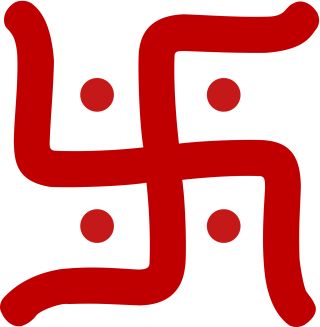Religion
How the Swastika Came to Be Appropriated by the Nazis
The swastika began as an Indian symbol of auspiciousness.
Updated May 28, 2024 Reviewed by Kaja Perina
Key points
- The Indo-Aryans, who migrated into the Indian subcontinent, referred to themselves as Arya.
- Centuries later, the concept of Arya got taken up and twisted by the Nazis.
- Hitler's Aryan notions led him to adopt and adapt the swastika.

The Indo-Aryans and the closely related Indo-Iranians descended from the Proto-Indo-Iranian culture which had developed on the Eurasian steppes north of the Caspian Sea (roughly, modern-day Kazakhstan). The Indo-Aryan migration from these steppes into the Indus Valley began in around 1900 BCE. The nomadic pastoralists who set off from their grassy homeland referred to themselves as Arya (“compatriot,” and, later, “noble”), and to their territory in the Indian subcontinent as Aryavarta (“Land of the Arya”).
At around the same time, their cousins the Indo-Iranians descended onto the Iranian plateau. In the sacred texts of Zoroastrianism, known as the Avesta, the Ancient Persians speak of themselves as Airya, from which derives “Iran.”
The Indo-Aryans and Indo-Iranians used Arya or Airya as a cultural and linguistic designation, not a racial one, and other Indo-European peoples never used the term.
How the term “Aryan” Came to Be Twisted
Perhaps because they believed the highly inflected and perfected Sanskrit to be the oldest Indo-European language, nineteenth century German philologists such as Max Müller and Friedrich Schlegel took to using “Aryan” as a catchier synonym for “Indo-European” or “Proto-Indo-European.”
At the time, "Aryan" was tied with the misguided Aryan Invasion Theory (AIT), involving a fair-skinned people subduing a darker, more backward indigenous population. The AIT helped to legitimize the presence of the British in India, although the discovery, in the early twentieth century, of the advanced Bronze Age Indus Valley Civilization did much to undermine its premises.
The term Aryan later got taken up and twisted by the Nazis, who began opposing an Aryan “master race” (Herrenvolk) to non-Aryan sub-humans (Untermensch).
In Nazi ideology, the tall, blond, blue-eyed Nordic race had remained purely Aryan, while the Aryans on the Asian fringes had degenerated through mixing with foreign races—which is why they had lost their combative vigour and become all dark, meditative, and philosophical. Thus, the original Aryans were no longer Aryan enough.
How the Swastika Came to Be Appropriated by the Nazis
Still, that did not prevent the Nazis from appropriating the swastika (Sanskrit, svastika, “conducive to well-being”), which Indians (including Hindus, Buddhists, and Jains) continue to use as a symbol of spirituality and auspiciousness.
The Nazi Hakenkreuz (hooked cross) differs from its inspiration in being black rather than red, in being rotated by 45 degrees, and in omitting the four dots between the four arms (see picture).
In his autobiographical manifesto, Mein Kampf (1925), Adolf Hitler, who once dreamt of being an artist, divulged the tortuous process by which he arrived at a flag for Nazi Germany:
I myself, meanwhile, after innumerable attempts, have laid down a final form; a flag with a red background, a white disk, and a black hooked cross in the middle. After long trials I also found a definite proportion between the size of the flag and the size of the white disk, as well as the shape and thickness of the hooked cross.
Implications for the Future
The story of how the swastika came to be appropriated by the Nazis shows how lazy academic notions might be seized upon by the half-educated in a bid to legitimise their agenda.
It is high time, I think, to stop referring to the Hakenkreutz as a swastika, and return their swastika to the Indians.
Read more in Indian Mythology and Philosophy.


